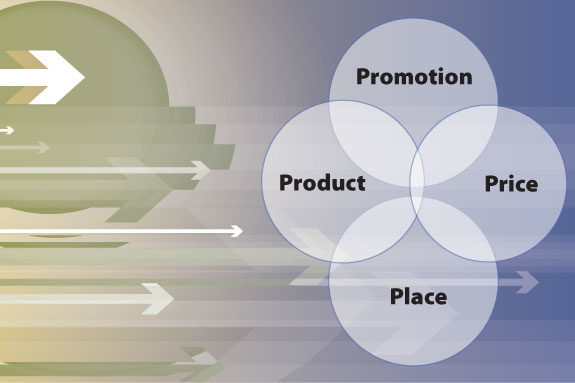The common lament among many agricultural producers is that they can do a great job of producing a product but aren’t that great at marketing it.
It is also widely accepted that the difference many times in being successful in any business venture is not the production but the marketing of the product.
While there is no doubt that you have to be able to produce something to market, it is also worth mentioning that many of the most successful farmers aren’t necessarily the ones that do the best job of growing a crop – rather the ones that can optimize their time and money to not only raise a marketable product but also market it.
The following discussion is designed to give current and potential hay producers some useful tools to do a better job in marketing their hay crop.
The four P’s of marketing
Most business schools teach the four P’s of marketing. They are:
- Product
- Place
- Price
- Promotion
While this short list may seem trite, the fact is that most successful producers break the marketing part of their operation into these four general chunks and then develop plans based on these items.
Price: The most important part of any marketing plan
Price is listed third in the list above only for alliteration purposes. In reality, it is perhaps the most important consideration, especially if the quality of the competing products is the same.
Determining the price to charge is a multi-step process – the first of which is to determine your breakeven price. Until you know what it cost to produce something, the market price is irrelevant.
Only after you have determined your cost of production can you evaluate it in light of the prevailing or anticipated market price.
In reality, there are two breakeven prices: The first is breakeven variable cost price and the second is the breakeven price to cover all costs.
Variable costs are also known as direct costs and include items such as fertilizer, fuel, labor and anything that, if altered, will change the level of production.
Covering your variable costs is the first part of any pricing decision and marketing plan. If you can’t cover your variable expenses then you can’t make it up on volume.
In developing your marketing/pricing strategy you must first determine your breakeven price to cover your variable cost. This is the price you must have.
Once this price is covered, you can then add fixed or overhead items such as payments, taxes, capital replacement costs, return to management, family living, etc.
These fixed costs are those items that will have to be paid regardless of the level of production. The total cost is the number you will have to cover over the long haul to be a viable business.

Notice in the formula that production is in the denominator. It is important that the production units be the same as the marketing unit. For instance, if you are selling tons, calculate costs on a per-ton basis.
If you are selling bales, determine your cost on a per-bale basis. The point is, use the same price units for cost or selling.
Product: What do I raise?
Determining the optimal product mix is a challenge for virtually every agribusiness firm, whether they have 10 acres of truck-crops or are a multi-billion-dollar international conglomerate.
As it relates to hay production, product includes not only the type of hay, such as alfalfa, timothy, bermuda, etc., but also form – such as round bales, small square bales or large rectangle bales.
Items to consider when deciding on the product mix include not only the potential profitability of the product but also the productive capacity of your soils and your other resources (labor, capital and management). If considering a new product, it also worth contemplating the “supposin’s.”
As in, suppose this market doesn’t materialize, suppose there is a production problem and so forth. This process is especially important if there is to be a substantial outlay of capital to either plan a new crop or invest in additional equipment.
Although space prohibits a full discussion, it should be mentioned that a substantial part of the product-mix decision should be risk management.
For instance, while some enterprises may be less profitable, they are still sure bets and can provide a certain amount of “guaranteed” money for the farm operation. Finally, it is imperative that any product be a profitable one regardless of the certainty of the income.
Place: Where and when to market?
Place is also an important consideration in marketing. As it relates to hay, place can refer to picking up hay in the field, at the barn, delivered or, for some producers, at a retail location.
There is usually very little one can do about the location of their hayfields or farms. However, it is worth mentioning that for every step past the hayfield, the additional costs of transportation, handling and shrink should be more than covered.
In addition to physical location, place can also refer to when to market. Just like other crops, there is usually a seasonal component to hay prices.

Figure 1 was developed by the Livestock Marketing Information Center (LMIC) and demonstrates the seasonality of hay prices.
When viewing the figure, readers should be mindful of two things. First, the figure depicts indices which show the price relative to the annual average.
Since the annual average is equal to 1.00, then indices above 1.00 indicate a month where prices are above the annual average whereas prices below 1.00 indicate a month whose price is below the yearly average.
The second item to notice is that the figure depicts the marketing year which goes from May through April. In terms of analysis, it is worth pointing out that “alfalfa” and “other hay” have similar patterns in that they peak in late spring, decline through the summer and then begin increasing in late winter and early spring.
Generally speaking, alfalfa prices will be below the annual average in the fall and winter months and above average in spring and summer. Conversely, other hay prices will be below average in summer and early winter and above average in late winter and early spring.
To be sure, these seasonal trends are not absolute and are affected by local supply and demand conditions. However, they should provide some useful information in terms of storage and pricing of hay.
Promotion: What makes your product so special?
Promotion is the last of the four P’s – but that does not mean it is the least important. At its core, promotion involves convincing potential customers to purchase your product rather than the competition’s.
In some instances, competition can be other hay producers but it can also refer to other types of hay.
As a result, it is important to know not only your product but the competition (read substitutes) for your product.
As a result, you can use this information to show potential customers how your product fits their needs. Some things that might be helpful to know about your hay product and other products include:
- What is your cost to the consumer on a per-pound of energy or protein basis?
- How does it compare to other types or forage or purchased feeds?
- If yours is more expensive, why should they purchase yours?
In addition to all of this information, you need to be able to get this information in front of potential customers.
While we could probably devote an entire article to this topic alone, several popular avenues of product promotion/advertising are shown below. This list is by no means exhaustive but should give fledgling hay marketers a good start. Some popular promotional outlets include:
- market bulletins published by many state departments of agriculture
- veterinary clinics
- auction markets
- livestock shows
- social media (Facebook, Twitter and Pinterest)
- Internet websites
- hay directories often provided by state Farm Bureaus and livestock associations
Again, this list is not exhaustive but should give you an idea of some venues to promote your product.
Summary
Whether they realize it or not, successful hay marketers know the four P’s of marketing: product, place, price and promotion.
Each of these are critically important and are vital to the success of your operation. In the end, most farmers will not take the time, nor should they, to develop a 200-page slick-back marketing plan.
However, they should take some time to consider the four P’s of their hay operation and see how they can use this information to develop a successful marketing plan.














